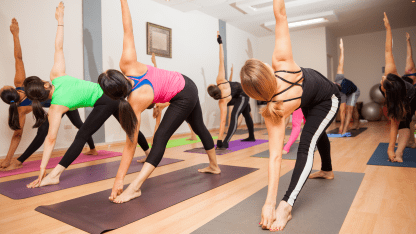Hello Scarlet Caps, it's me, Kelly, the team yoga instructor. Over the years the one question I've gotten probably more than any other is, How do I find the right yoga class for me? Which is almost always followed by, I'm not very flexible.
It's a great question, and flexibility has nothing to do with it. Yoga has exploded in popularity in recent years and there are a dizzying array of styles to choose from. One is not better than the other, they're just different. Like my Dad always says, that's why they make chocolate and vanilla ice cream...people have different tastes.
There are a number of considerations to think about.
Finding a Yoga Class That's Right For You

By
Scarlet Caps @ScarletCaps / https://www.scarletcaps.com
Style
There are a lot of different yoga styles these days, ranging from the more traditional Iyengar to more recent arrivals, such as Bikram. I'm not going to run through the list of various styles here; the main point is that one style isn't better than another; what matters is what feels right to you. Most of us would benefit from a range of styles to make sure we are continuously learning and evolving.
Personality
Students are often surprised that classes taught by instructors trained in the same tradition can have significant differences in tone and instruction. That's mainly because our individual personalities influence how whatever style we trained in comes out. For example, I tend to play music that you'd hear on the radio, while other instructors prefer more traditional instrumental or new age music. Some instructors include chanting in their classes (I do not...no one wants to hear me sing); others stick to the Sanscrit names of the poses, while some of us prefer to use the Anglicized versions, so down dog instead of Adho Mukha Svanasana.
Goals
One thing to consider is why you want to take a yoga class in the first place. Are you recovering from an injury? Do you want to improve overall health and well being? Relax more? This might matter in your choice of a class because certain styles lend themselves to some goals more than others. For example, I do not recommend more athletic styles of yoga if you're first starting out because contrary to popular belief, you can, and many people do, get injured in yoga. If you want to manage stress more effectively, then maybe a restorative yoga class would be of benefit.
Level
Typically, yoga classes are classified one of two ways: level 1, 2, 3 or all levels; or by the name of the style, such as Flow, Restorative, Iyengar, Freedom Style, etc. In the end, what often matters more is who is teaching the class because there are no agreed upon definitions for most of this. Everyone has his or her own interpretation of what level 2 means, for example. Besides, sometimes what the class description says does not match how everyone in the class is feeling so a good instructor will realize that and adjust accordingly.
Where to Go
Yoga is offered in a wide variety of places these days (even hockey rinks!). Yoga studios, gyms, churches, community centers and office buildings are some of the most common places to find a yoga class. A yoga instructor is a yoga instructor. One is not better, more experienced or more advanced based on where the classes are taught. Nor are classes "better" in one type of location than another. It's true that there is a tendency for yoga classes offered in gyms to be more like "yoga aerobics" but this is not the case everywhere.
This is not an exhaustive list of considerations, but I hope it's useful.
As you have likely figured out by now, there are a lot of factors at play that influence what is a good fit and what's not. Your mood and energy level on any given day may matter more than anything. It's going to take some experimenting. When you find an instructor and a class that you like, don't be shy about asking about other classes with a similar vibe or teaching style. Ask other students too, they are often familiar with several, if not most, of the instructors at any given location.
Good luck!
- Kelly


















